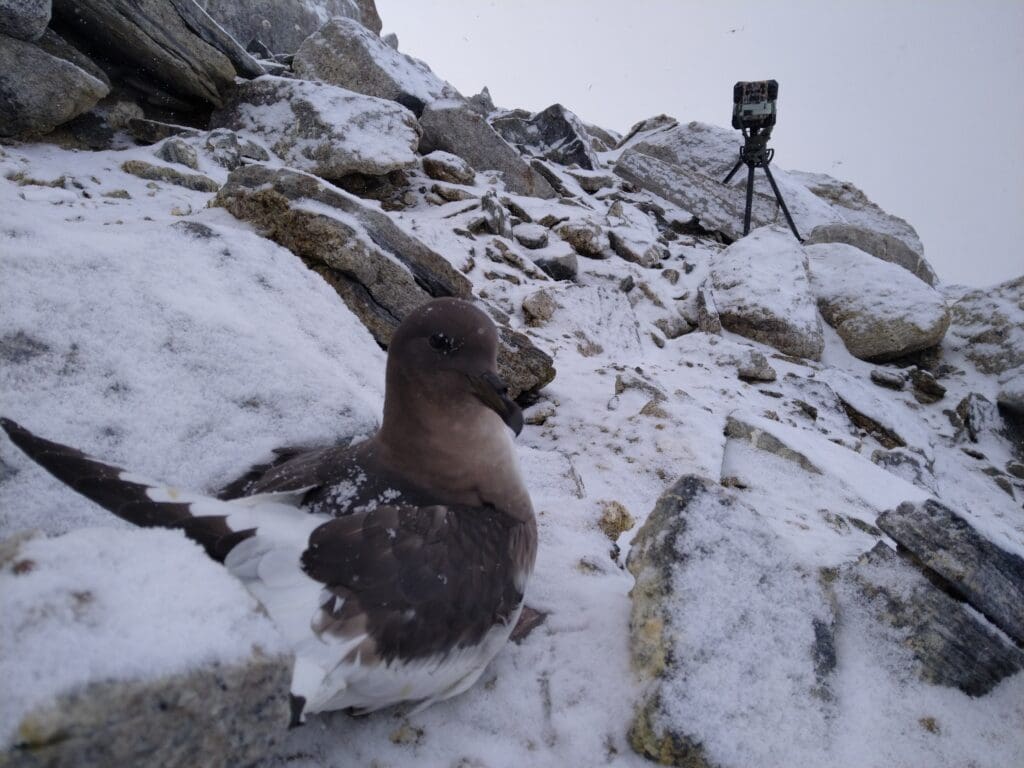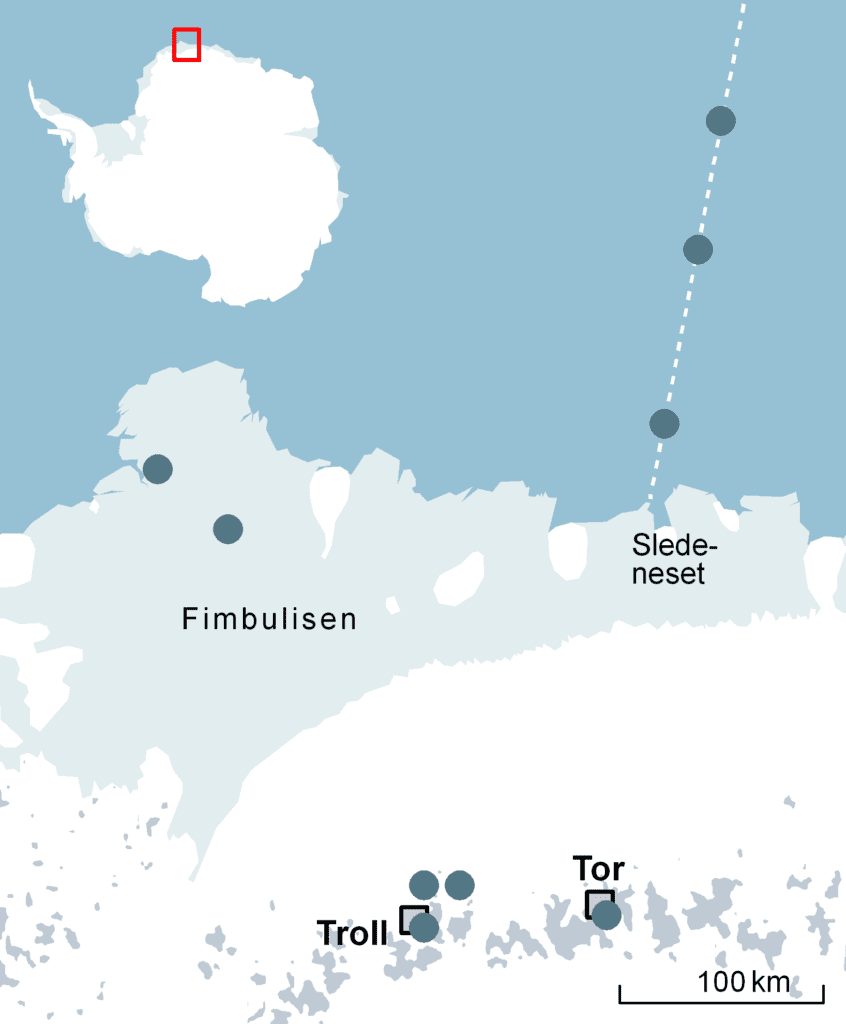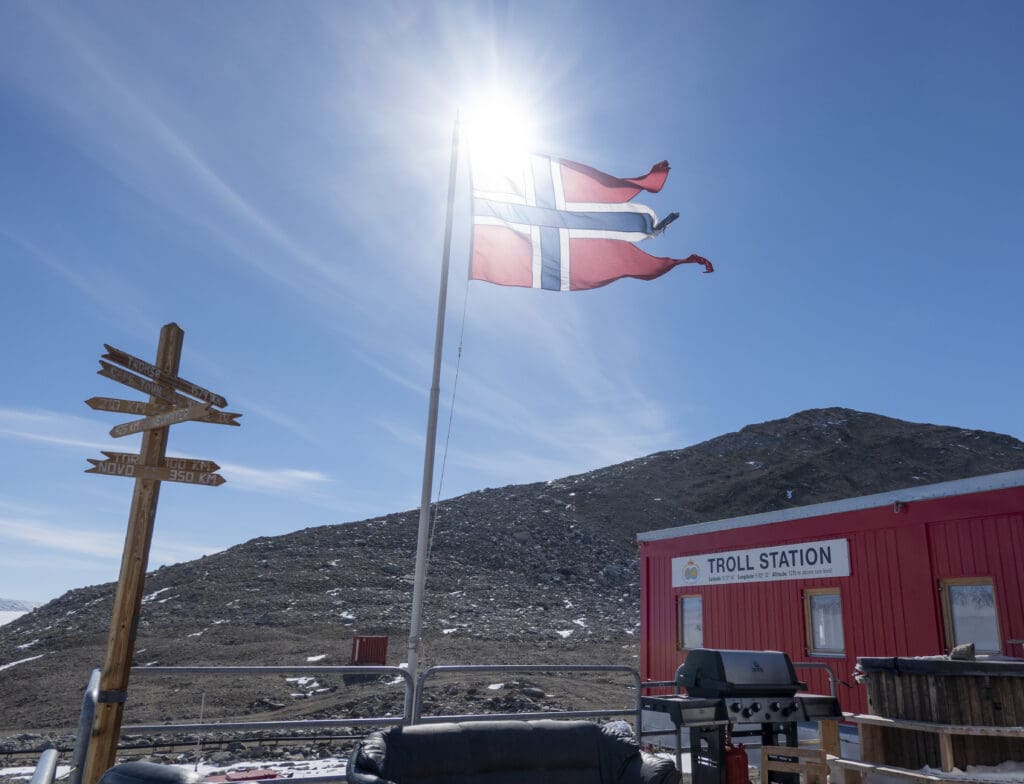What do Antarctic petrels in Svarthamaren, soil structure movements at Troll research station and ocean chemistry in the Håkon VII Sea have in common? They will all be studied at the Troll observing network currently being established at Troll research station in Dronning Maud Land in Antarctica.
By: Christina A Pedersen, Birgit Njåstad, Sebastien Descamps, Tore Hattermann, Stephen R Hudson, Stig Flått and Stein Tronstad // Norwegian Polar Institute, Wenche Aas // NILU – Norwegian Institute for Air Research, Elin Darelius // University of Bergen, Wojciech Miloch // University of Oslo, Johannes Schweitzer // NORSAR, Rune Storvold // NORCE

When the new research infrastructure – Troll observing network (TONe) – is complete, important and relevant climate and environmental data will be available to all researchers, thereby helping to create new knowledge about Antarctica and the Southern Ocean. If you are a researcher with an interest in Antarctica, we invite you to work with us!

Let’s take a step back and explain why TONe is being established. Most people who have conducted research and monitoring in Antarctica know that it is demanding, hazardous and extremely expensive.
Why is it still important for Norway and Norwegian researchers to carry out research and monitoring on this continent? The answer is that Antarctica and the Southern Ocean are key drivers of the climate changes and sea level rise that affect processes related to circulation systems for the entire world.
To understand these systems and processes, we need knowledge about them, and in order to get that knowledge we need good and accurate observational data.
Norway cooperates internationally in Antarctica to make the world community better equipped to meet the various environmental and climate challenges we all face, and it is important for Norway to contribute to this international knowledge-generation effort. Through TONe, we also contribute to strengthening Norway’s scientific credibility and standing.

Norway has a long history of conducting mapping, research, and monitoring in Antarctica. Previously, the activity was largely based on expeditions, but with the establishment of a year-round research station at Troll in 2005, Norway gained a new platform for monitoring activities.
Despite limited long-term funding, Norwegian actors at the Troll station have built and maintained a few time series for climate and environmental monitoring in Antarctica. This is a Norwegian research environment, with the Norwegian Polar Institute at the forefront, so it is time to gather our forces for a joint effort.
The Research Council of Norway put out a call for research infrastructure of national importance – which seemed right on target – and on the second try the project application met with success. A total of NOK 157 million was granted for the establishment of TONe in 2022. The infrastructure will be established over the next five years, and the partners are obliged to operate it for a further five years. Since we are talking about monitoring and long time-series, we are aiming for long-term continuity.
TONe is in the initial phase of being developed into a national, state-of-the-art, multidisciplinary, multi-platform, distributed infrastructure network. The network will contribute to long-term data collection from the Troll research station and other parts of Dronning Maud Land, where data are otherwise scarce. The infrastructure consists of three main components: eight observatories; a shared infrastructure service; and a data management system that will make data available for the entire research community.
The observatories will contribute to understanding climate processes and changes in the atmosphere, sea and ocean circulation, the inland ice and the ice cap’s influence on sea level, as well as changes in the ecosystem at sea. Basic research will also be carried out to understand processes and monitor conditions. The result will be fundamental data for anyone who wants to research nature in Antarctica.

Facts about the Troll research station
- Established in 1989, upgraded to a year-round station in 2005.
- Located in Dronning Maud Land, at an altitude of 1275 metres in Jutulsessen in Gjelsvikfjella, 235 km from the coast.
- Operated by the Norwegian Polar Institute, on behalf of Norway.
- Supports Norwegian and international scientific activity in Antarctica.
Atmospheric Observatories
At the ionosphere observatory, the University of Oslo will establish a digisonde system that measures electron density in the ionosphere. The instrumentation will contribute knowledge about the southern lights, turbulence in the ionosphere and space weather that affects satellite communication.
NILU will further develop its existing infrastructure on Trollhaugen by the Troll station. Three new instruments will be established at the atmospheric observatory: 1) one to measure aerosol size distribution, which is important e.g. for studying transport of particles from forest fires in the southern hemisphere; 2) one for measuring trace gases important for validation of satellite data; 3) and one for high-resolution measurement of greenhouse gases (CO2 and methane).
The Norwegian Polar Institute will establish a completely new integrated cloud observatory at Troll. The observatory will enable us to understand the link between clouds and aerosols and their role in radiative balance, and contribute insight into the importance of these mechanisms for the warming of Antarctica.
NORSAR will establish an infrasound array (collocated with the seismic array). Measurements of infrasound waves in the atmosphere provide information about atmosphere dynamics and the vertical coupling between the atmospheric layers, and increase our understanding of processes in the atmosphere.
Fixed Earth Observatory
NORSAR will establish a nine-element seismic array (seismic antenna) at Troll, which will provide information about earthquakes, icequakes and other sources of seismic waves. The array provides information about both the seismic sources and the structure of the Earth. In combination with the infrasound array, the seismic array will monitor cryosphere dynamics in Dronning Maud Land.
Marine Cryosphere Observatories
The Norwegian Polar Institute will carry out a new drilling campaign through the several hundred metre thick Fimbul Ice Shelf and place instruments for measurements in and under the ice shelf. The Fimbul Ice Shelf Observatory will continue similar measurements established during the latest international polar year (2009). This will enable us to study the impact of the melting of ice shelves on sea level rise, temperature changes in the area, and the possible drivers behind the changes.
At the multidisciplinary ocean mooring observatory, the Norwegian Polar Institute and the University of Bergen will further develop existing ocean moorings and oceanographic measurements of the continental slope at 6°E in the Håkon VII Sea. The aim is to improve the understanding of processes and systems, so we can see how the ecosystem adapts.
The Polar Institute has been monitoring the Antarctic petrel colony at Svarthamaren since the 1980s. These birds nest on land, but feed on krill, which they collect from the sea. By monitoring the petrel colony, we gather information about the environment in the sea. The seabird observatory will improve the monitoring by setting up automatic monitoring systems in two bird colonies in the area.
In order to supplement and enhance data collection from the observatories, NORCE and the Norwegian Polar Institute will develop a drone service as a smart and cost-effective way to collect large amounts of data over vast areas and at several altitudes, with a minimal footprint. The drones will have a flight endurance of up to 10 hours and a range of 1000–1500 kilometres, enabling data collection over a broad portion of Dronning Maud Land. The drones will be equipped with various types of radars for snow and ice measurements, high-resolution cameras and sensors for hyperspectral image recording, as well as meteorological sensors and radiation meters. Researchers are encouraged to apply for research projects that make use of the drone service. The consortium hopes to be able to add more shared infrastructure services for the research community in the years to come.
The data management system will archive and provide access to all the data from the observatories and the drone service, and is an integral part of the infrastructure. Secure and automated storage will be provided at Troll to safeguard the raw data and protect their integrity. A TONe portal on the internet will provide the users with data access, as well as a booking interface for the drone service and the field services.
The infrastructure will be ready for use from April 2027, while some of the individual components will be available earlier.
We want to encourage the entire Norwegian Antarctic research community to make use of the new infrastructure by applying for funding for new projects, from both Norwegian and international sources. We believe that TONe will make the Norwegian Antarctic research community as a whole more attractive for international cooperation in the years to come.

Two arguments justify maintaining a Norwegian station in Antarctica:
- A well-located research station will give the nation the opportunity to contribute to the efforts to understand how Antarctica is affected by and contributes to global climate change. Such knowledge will contribute to developing the knowledge required to find solutions to tomorrow’s major societal challenges.
- In 1959, twelve countries, including Norway and the six other claimant countries, agreed to dedicate Antarctica to peace and science through the Antarctic Treaty. The prerequisite for being a determining party to the treaty is to show particular interest by conducting significant scientific research activities in Antarctica. With the Troll station, Norway has a starting point for rigorous scientific activity, while at the same time the station gives the country political and professional legitimacy and standing in the Antarctic treaty system.

